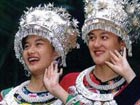| Videos | ? Latest |
|
? Feature | ? Sports | ? Your Videos |
Chinese folk fashion displayed in Beijing
China's cultural development can also be seen through the panorama of folk fashions which are now being featured at Colorful China, an exhibition in Beijing stitching together ethnic costume treasures from all of the country's 56 ethnic groups. In this edition of Spotlight, an in-depth look at these ethnic and folk fashions, most of which are dying out as young people chose a more modern look.
Bai Fengxian proudly shows off her lavish Dai ethnic group costume from Yunnan Province. This is their holiday best and is only worn during important festivals and weddings. Made by hand, it usually takes a year to create this wonderful costume.
Such clothes provide a record of the history and folklore, and bear the totems of the ethnic minorities' beliefs. The weaving together of every yarn also demonstrates the delicate craftsmanship and wisdom of the local people.
Featuring a collection of more than one hundred costumes from China's 56 ethnic groups, some of the exhibits are in fact antiques more than five hundred years old.
Shen Xiaoying from the Yi ethnic group of Sichuan province notes the rich coloring and delicate embroidery work of their costumes.
Shen said, "The costumes of young women in our ethnic group are distinguished with three colors -- red, black and yellow. Black represents the earth and symbolizes solemnness. Red stands for fire and it symbolizes vigor. And yellow stands for gold and it means brightness."
Colorful China is organized by the Chinese Folk Artists' Association. It draws attention to the high artistic virtuosity and research value of ethnic costumes, including dresses, decorations, fabrics, batik and embroidery.
The exhibition also records achievements in preserving the folk and ethnic fashions since the Association launched a nationwide campaign in 2006. Organizers believes hand-made costumes are an art and one of China's cultural heritages that still exist, even in an increasingly modernized China.
The association invited some crafts people and designers to the Beijing exhibition to demonstrate their techniques. They are the heirs of their unique traditions and are increasingly important as the number who still master the traditional techniques which are dwindling.
Li Xingxiu is from the Qiang ethnic group in Sichuan Province. They were severely battered during the devastating earthquake in May of 2008. She says as long as she and her fellow artisans are alive, they will not let this art die.
Li said, "There are fewer and fewer young people who can make our traditional costumes. But all the elderly people who are over 70 years old can hand make these costumes. Thanks to the preferential policies and such platforms, we can preserve and hand down this art to the next generation. This is our best chance to introduce our traditional Qiang culture and let more people know about us."
Li says the Qiang ethnic group has existed for three thousand years and their costumes show a wide range of symbols. Many are drawn from daily life but with hidden meanings. The Qiang costume can be easily discerned by its unique pattern of auspicious cloud.
The raising of silkworms, extracting the silk, weaving the yarn into cloths and then the dyeing and embroidery work, each process is a testament a woman's wisdom and hard work.
The free exhibition will run at the Cultural Palace for Nationalities in downtown Beijing until this Saturday. Ethnic fashion shows will also take place everyday during the exhibition.

 0 Comments
0 Comments






